Growing peppers from seed can be a bit challenging for beginners, but it’s actually pretty easy when you know how to do it.
Once you learn a few of my special tricks, you’ll see just how simple it can be. In this guide, I’m going to show you exactly how to grow peppers from seed, step-by-step.
I’ll cover everything from the best method to use, when to start, and planting instructions, to germination time, seedling identification and care, transplanting, and more.
Growing Peppers From Seed
| Days to germination | 10-12 days |
| When to start indoors | 8-12 weeks before transplanting |
| When to sow outside | 2-3 weeks after your last spring frost date |
| Days to maturity | 60-150 days (depending on the type) |
| Sun exposure | Full sun |
| Seed planting depth | ¼ – ½” deep |
| Plant spacing | 12-18” apart |
| Soil temperature | 65-85°F |
Types To Grow
One of the things that I love the most about growing pepper seeds is the amazing number of varieties there are to choose from.
You can’t get much diversity buying starts at the garden center because they usually only carry a handful of common ones. But the variety of different types of seeds you can find is awesome.
You name it, I’ve probably grown it! Some of my favorites are cayenne (hot), jalapeno (hot), bell (mild), padron chile (mixed), and purple bell (mild).

How Long From Seed To Harvest?
Depending on the type you have, it can take anywhere from 2-5 months (60-150 days) to grow peppers from seed to harvest.
Some varieties will mature much quicker than others. And, of course, all of them will start producing faster in ideal conditions. So give them plenty of heat and sun for the best results.
Related Post: How To Grow Your Own Peppers
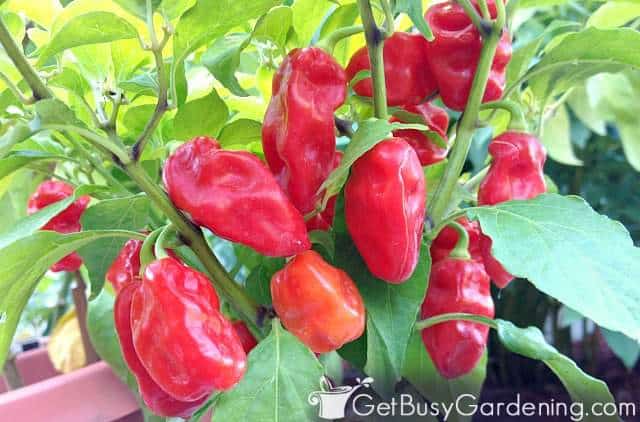
Tips For Planting Pepper Seeds
There’s nothing special you have to do to prepare your pepper seeds before planting them. You don’t need to nick, soak, or stratify them. But it is important to use the right sowing method, and to start them at the correct time.
Pepper Seed Starting Methods
There are two sowing methods you could try with your pepper seeds: 1. starting them indoors, 2. direct sowing.
- Starting them indoors (best method) – Since they can be slow to germinate and require a fairly long growing season, I recommend starting your pepper seeds indoors.
- Direct sowing – If you live in a warm climate where your winters are very short, then you could sow them directly into your garden in early spring after all danger of frost is gone.
Related Post: 3 Seed Starting Methods That Every Gardener Should Try
When To Start Your Pepper Seeds
You should start your pepper seeds indoors 8-12 weeks before your average last spring frost date. They require consistent heat and moisture to germinate, and the seedlings need plenty of time and light to grow strong and healthy.
The exact date to sow them depends on where you live. I’m in MN (zone 4b), and our average last frost is around May 15th. So I start mine sometime in early to mid March.
How To Plant Pepper Seeds Step-By-Step
Below is a list of what you’ll need to start your pepper seeds indoors, as well as the step by step planting instructions.
Supplies Needed:
- Pepper seeds
- Seedling flat with a lid
- Seed starting soil or peat pellets
- Water
- Hand trowel
- Heat mat (optional)
- Latex gloves (if planting hot pepper seeds)
- Soil thermometer (optional)
- Moisture meter (optional)
Pro Tip: A quick word of caution here: if you want to plant the seeds from hot peppers, make sure to wear disposable gloves. Otherwise the capsicum oils can get on your hands, and cause discomfort (or worse, get in your eyes, OUCH!).
Related Post: How To Dry Peppers (5 Best Ways)
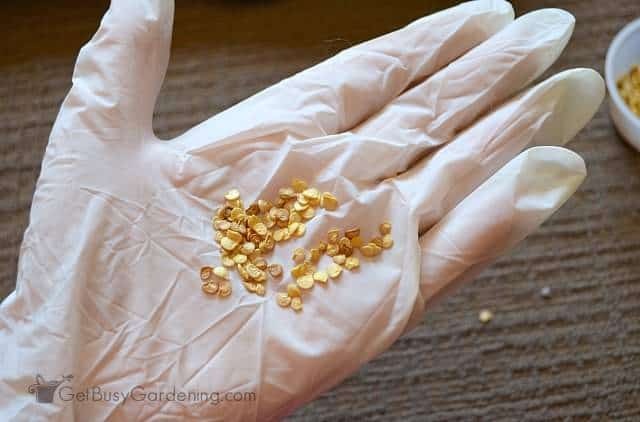
Step 1: Fill the seed trays – Fill the cells with damp seed starting soil, or pre-moisten your peat pellets and place them into the trays.
Step 2: Decide how many seeds to use – If you’re using brand new seeds, then you can just plant one per hole. Otherwise, if they are old or have a low viability rate, then plant 2-3 per cell/pellet.
Step 3: Plant the seeds – You can either lay your pepper seeds on top of the soil, and gently push them down 1/4 – 1/2″ deep. Or you could make the holes first, then drop the seeds in.

Step 4: Bury the seeds – Fill the holes back in, then gently press down to make sure the seeds come in contact with the soil. Don’t compact it though, just lightly pack it.
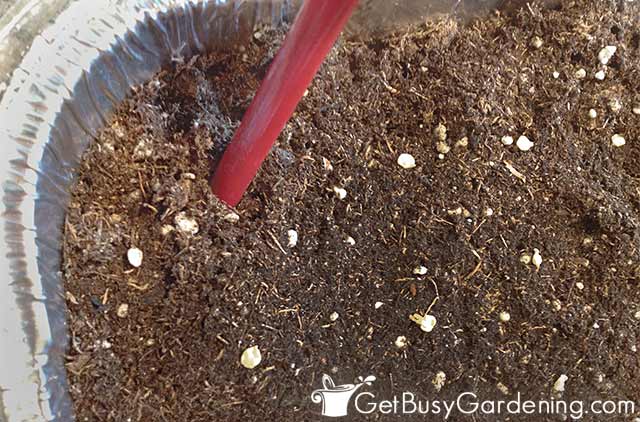
Step 5: Add water – If the soil is not already moist, then you should dampen it. It’s best to water the trays from the bottom rather than over the top, so you don’t accidently displace the pepper seeds.
Step 6: Cover the tray – Place the clear plastic lid on top of the tray to help keep the soil warm, and ensure that it stays moist.
Step 7: Place the tray in a warm spot – If you can, put it on top of a heat mat. That will help speed up germination. Otherwise, place it in the warmest spot you can, or run a space heater nearby. If it’s too cold, it will slow down or inhibit germination.
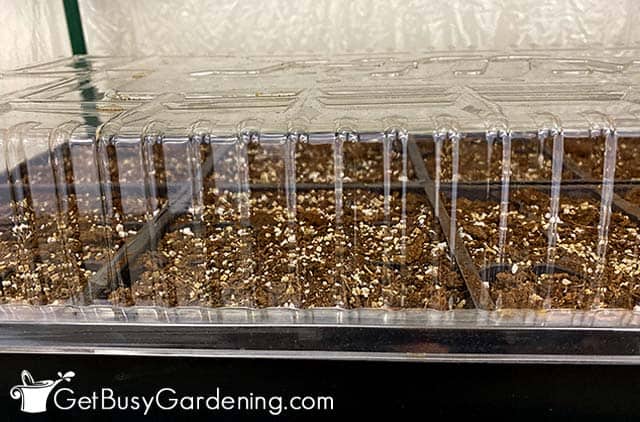
Pepper Seed Germination Time
On average, it takes 10-12 days for pepper seeds to start growing, but some varieties are slower than others. You might see a few of them sprouting in as little as 7 days, while others can take almost a month.
To speed things up, put the tray on a heat mat or over a vent. It’s amazing how much faster they germinate when you add bottom heat.
What Do Pepper Seedlings Look Like?
When they first sprout, pepper seedlings will have two leaves that are narrow and pointy. Those are called the “seed leaves” (or cotyledons, if you want to get super technical).
All of the others that grow after that are called “true leaves”, and they look like regular leaves only they’re much smaller. Those will usually start forming within a week or so after the first two seed leaves have opened up.
Related Post: How To Can Peppers
How To Care For Pepper Seedlings
Once your pepper seedlings start to grow, you’ll need to give them the proper care from the moment they emerge. You can learn all about general seedling care here, but below are some specific tips for peppers:
Water
Pepper seedlings need consistent moisture, but they don’t like soggy or wet soil. Allow the very top to dry out a bit between waterings, but never let it dry out completely. Use a moisture gauge to help you get it right.
If you accidentally overwater, take the lid off of the tray and run a fan over the top on low to help the soil dry out a bit.
Light
If pepper seedlings don’t get enough light, they will start to grow leggy and reach for the nearest window. So, to keep them straight and compact, it’s best to supplement with artificial light.
Hang a grow light a few inches above the tray as soon as they germinate, and use an outlet timer to keep it on for 14-16 hours per day.
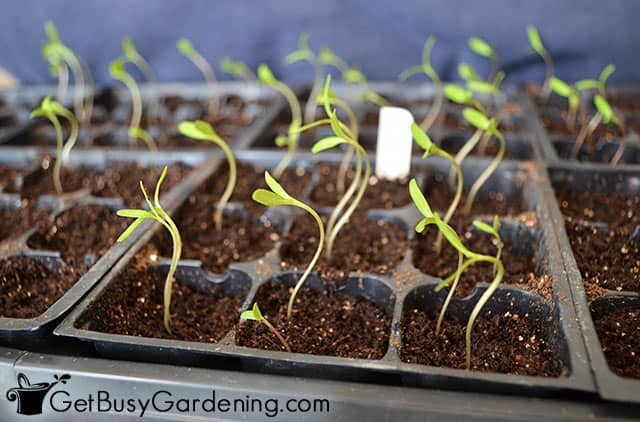
Fertilizer
Once the true leaves begin to form, it’s time to start fertilizing. But don’t give them a full strength dose right away. Use a weak dose at first, and slowly increase the strength as your pepper seedlings grow larger.
I use (and highly recommend) an organic compost solution (sometimes I make my own with compost tea bags). Or you could use a plant starter fertilizer.
Air Circulation
Once all (or most) of the seeds in the flat germinate and start growing, it’s time to give your pepper seedlings some airflow. Remove the lids, and run an oscillating fan over them on the lowest setting.
This will help to strengthen them, and also prevents problems with mold growth in the seed trays. Plug it into the same timer as your lights, or run it for a shorter period if you prefer.
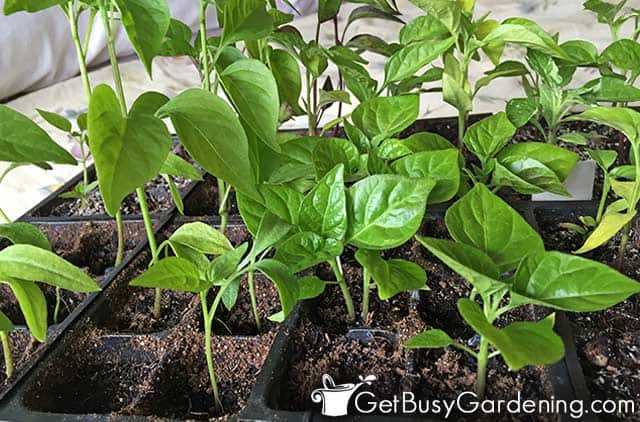
Potting Them Up
Once your pepper seedlings are twice as tall as the tray, pot them up into larger containers to give them plenty of room to grow.
I like using plantable pots to make it easy to transplant them into my garden. If you like that idea, but prefer a more sustainable alternative to peat, try coco coir or cow pots.
Otherwise, you can use small plastic nursery pots, which are reusable. Or even recycled containers like yogurt cups or small milk cartons, just be sure to poke drainage holes in the bottom.
Related Post: How To Prune Peppers For Maximum Production
Transplanting Pepper Seedlings Into Your Garden
Pepper seedlings hate the cold, and transplanting them too early can stunt their growth or even kill them. So wait until all chance of frost is gone, and the ground is at least 65°F. Use a soil thermometer to check it.
But before you can even think about planting them into the garden, you must harden your seedlings off first to prepare them for life outdoors. Do not skip this step.
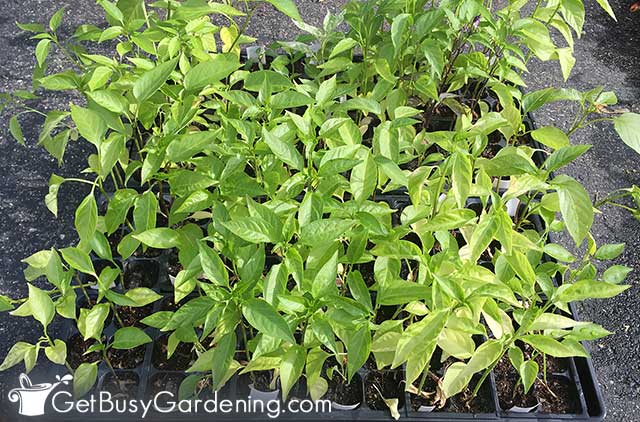
FAQs
By far the fastest way to germinate pepper seeds is to add bottom heat. They will sprout much, much faster if you put the tray on top of a heat mat or place them in a warm location.
No, pepper seeds do not need light to germinate. However, the seedlings will start reaching for the nearest window as soon as they sprout, so be sure to turn your grow lights on right away.
Pepper seeds won’t germinate when they’re old, if it’s cold, or the soil is either too wet or dry. Maintain even soil moisture and keep the temperature between 65-85°F. If your seeds are older than 2 years, sow 2-3 per hole and thin them later.
You can plant seeds from a pepper that you got at the grocery store or one that you grew, as long as they are mature. Small, immature seeds will not germinate.
Growing pepper seeds is easy once you get the hang of it. Following this detailed guide will give you the best results. Plus, once you learn how, you will be able to grow any variety that you want.
If you’re tired of struggling, and want to learn how to grow any plant you want from seed, then enroll in my online Seed Starting Course. It’s a wonderful, fun, self-paced course that will teach you everything you need to know to easily grow your own seedlings. Enroll and get started today!
Or, if you just need a refresher, then my Starting Seeds Indoors eBook is for you! It’s a quick-start guide that will get you planting seeds in no time.
Share your tips for growing peppers from seed in the comments section below.
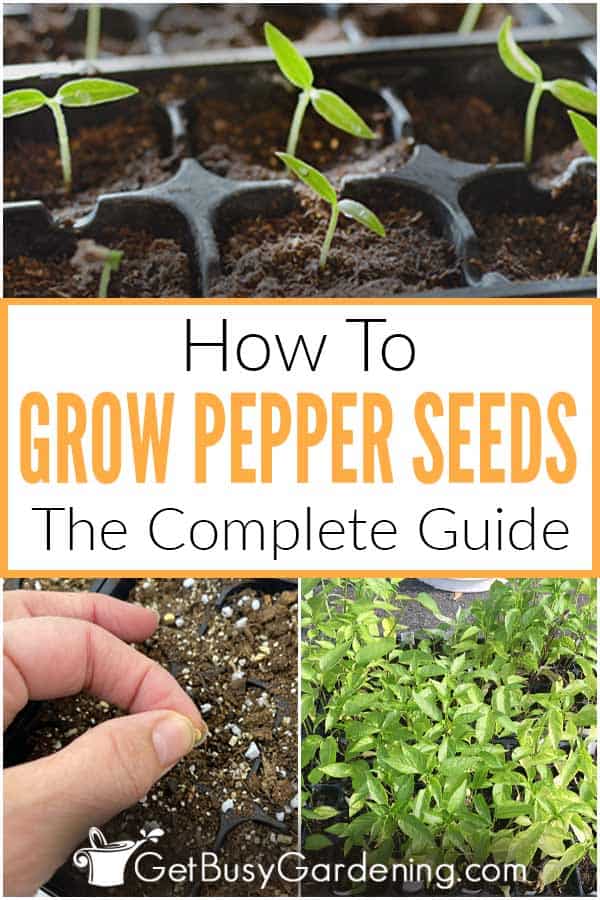
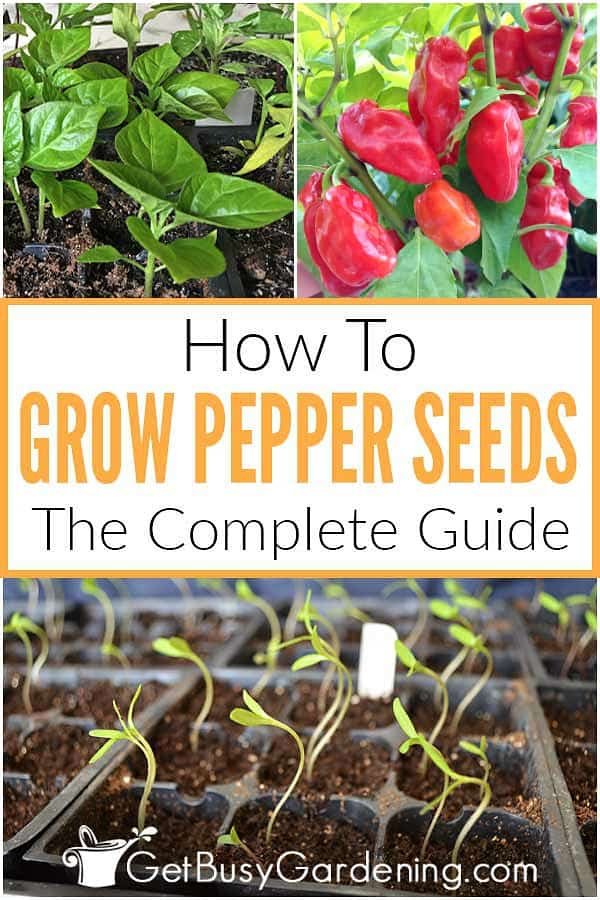
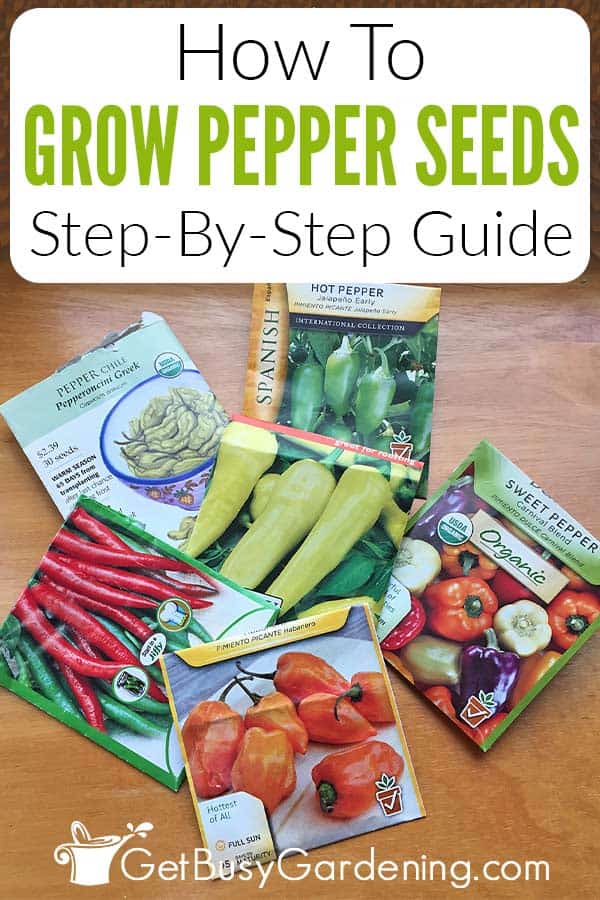
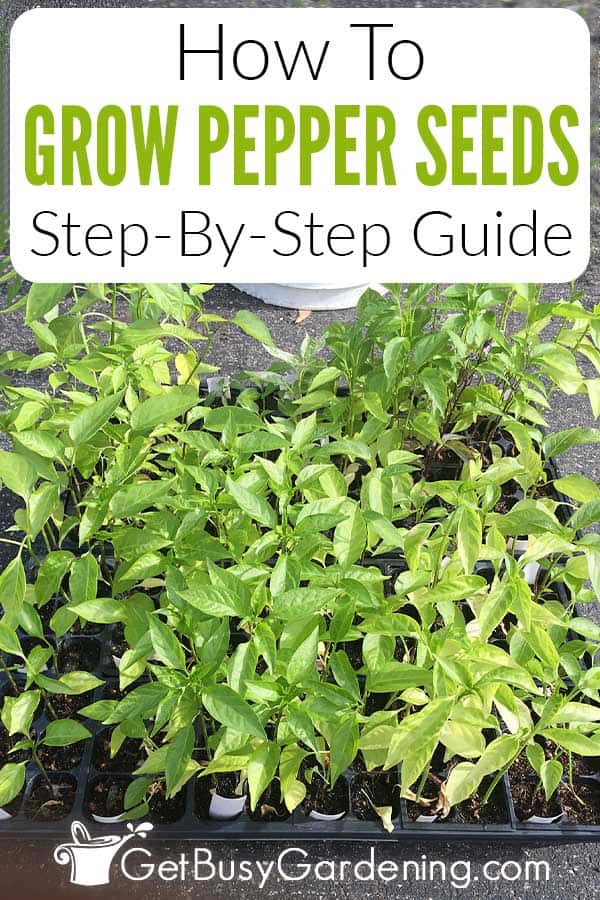
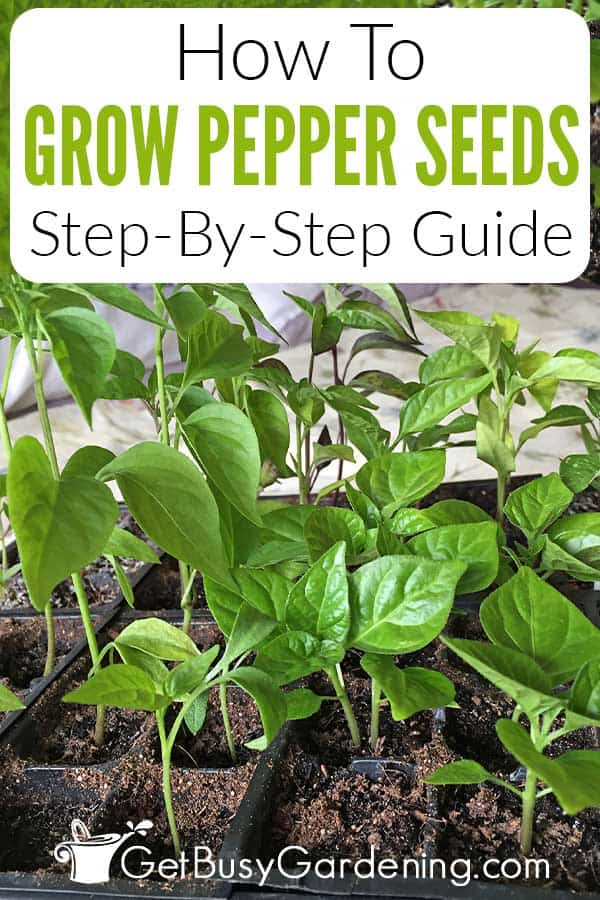




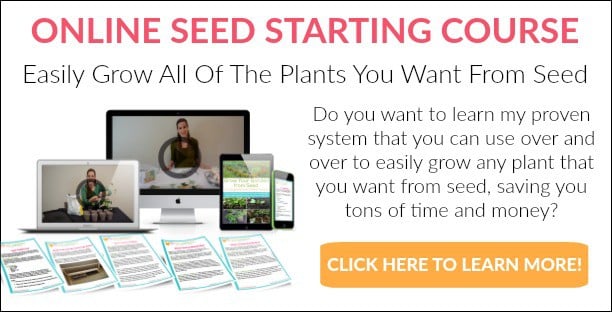

Elaine Moore says
Hi my seeds have shot up in a week but seem very leggy do they need support?
Amy Andrychowicz says
If your pepper seedlings are getting leggy, that means they need more light. A grow light works best, as a sunny window doesn’t usually provide enough light indoors.
lynne says
hello… my kids planted the seeds from a pepper…. the planting was haphazard and then they got left out in the rain the pot got totally filled with water tipped up and it was a mess. anyway i didnt do anything with the container thinking it was doomed and suddenly i have basically a grass like carpet filling the pot …amazing pepper babies thriving in such adversity!!…. how can i help the amazing baby peppers now? do i pot on into pots? or do i move directly to the garden? id love some help. i have grown many veggies but never peppers. thank you.
Amy Andrychowicz says
Haha, isn’t that how it goes sometimes! How fun for you kiddos! If the pepper seedlings are large enough to be transplanted into the garden, and there’s no more chance of frost in your area, then you can go ahead. Otherwise, if they need more time, you can pot them up into larger containers, or simply thin them so the healthiest ones can grow larger. Here are a few articles that will help you out…
– When To Transplant Seedlings Into The Garden
– How To Repot Seedlings Into Larger Containers
– A Beginner’s Guide For Thinning Out Seedlings
Sandria says
My peppers are grown they are in full sun but they are not sending out blossoms and it’s over six months now please help me thanks
Amy Andrychowicz says
Peppers need hot weather, and 8+ hours of direct sunlight in order to bloom. If you’re sure those two requirements are being met, then it’s probably too much nitrogen in the soil. I would start feeding them with a fertilizer that’s made for peppers and tomatoes, or one that’s higher in phosphorus (the middle number on the package). Here’s my full guide to pepper plant care, which has all the details for fertilizing, sunlight, watering, etc… How To Grow Peppers: The Ultimate Guide.
Noel says
My seedlings are not growing fast in nursery what can I do its been 23 days but they are too little
Amy Andrychowicz says
If your pepper seedlings aren’t growing, then it could either be too cold or too wet for them. Ensure that you’re not overwatering, and that the soil is never soggy. And move them to a warmer location, or add a heat mat. They need a lot of heat to grow. For faster growth, the temperature should always stay between 75-85F degrees.
Aileen Chiu says
Hi I would like to know how many seedlings needed in half hectare? I leave in a tropical country. I will try to plant sweet pepper. Thank you.
Amy Andrychowicz says
The plants don’t need a lot of room to grow, so space your pepper seedlings 18-24″ apart.
Amy says
I am going to start an I door garden peppers for sure being in my garden! I have been saving seeds from the last couple times I have bought peppers from the store have you ever started your plants this way? How long do your seeds need to dry out?
Amy Andrychowicz says
Yes, I have tried growing the seeds from grocery store peppers before, and it works just fine. I let the seeds dry out for a few days before planting them. Have fun!
johanna says
hi! i have a couple pepper plants and one of them has a small pepper growning but it grows really slow, has been like 3 or 4 weeks and is still small and green, how long does it take to grow? should i cut some of the leaves? its winter but that plant its inside the house near a window for the sun.
what should i do with this plant and how to i prepare the rest of my plants for spring
thanks
Amy Andrychowicz says
Pepper plant grow much slower indoors (especially during the winter) than they do outdoors during the summer. You could try giving it some organic fertilizer (like a liquid compost tea or an all purpose plant food) to give it a boost. Just make sure it’s getting plenty of light, or it could start to grow leggy. Pinching out some of the flowers and leaves should help the pepper grow faster.
Nav D says
Nice detailed information. One piece of information that I am not able to find out from anywhere and would appreciate if someone can provide… when to take the Humidity Dome off of the tray.
So here is what I do but not very successful. If someone can comment what step is wrong that will be really great. I am having trouble growing Bell Peppers, Hot peppers, Egg Plants.
Tomato and other veg grow fine every year.
I am in Hartford CT area.
In the unfinished basement I set it up like this.
Mix Jiffy Organic Seed starter mix with water in a container
When mix is well moist in 4-6 hours I fill the pots
leave for a day or so to drain excess water
then put 2 seeds a pot and cover very lightly without pressing much or at all.
Cover the tray with dome
place a heat mat under the tray
and this whole setup is in a brown closed box with a hygrometer inside
temps is mostly around 80 and humidity in the box is about 40-50
dome gets full of water in a day.
and here is the problem starts……
in 4-7 days first seeds start sprout and only few come scattered. at that point I am not sure to keep the dome for remaining 75-80% seeds to sprout or remove dome to provide air and light to the ones that grew. And in that struggle mostly die off or are leggy.
Now what I did today was opened the box from top, put a plywood plank on top and made a 8 inch whole in the middle of plank to put a light of full spectrum cfl bulb 100 watts.
But kept dome still on. I do have a full spectrum light fixture 4 ft with two 32 watts T8 bulbs and transfer plants under it as soon as I can and have a fan too.Bot on timer 6 am to 9 pm.
I don’t know if what I did this morning will work better. Any suggestions please.
Amy Andrychowicz says
Is the lid on your trays clear? If not, then you should definitely switch to using a clear lid to make it easy to give the germinated pepper seedlings adequate light. Then, turn on your grow lights as soon as the first pepper seeds start to grow. It’s ok to leave the lids on and the heat mat running until the other seeds sprout (as long as the lid is clear), but the seedlings need light as soon as they start growing or they will become leggy. If 75-80% of your seeds are not germinating, then I would test their viability to see if the problem is old/infertile seeds. Here’s more information about general seedling care which will also help you out. Good luck!
Sam says
I’ve never had much luck with growing peppers. Maybe with this advice I might get a crop – I definitely need to have another go at it!
Amy Andrychowicz says
Yes, peppers are fairly easy to grow from seeds, but do need a bit of special care. Hope yours will grow well for you this year!
Shirley Wood says
I enjoy growing sweet peppers from seed and making Pepper Jelly. Great info.
Amy Andrychowicz says
Yum, pepper jelly! That sounds awesome!
Linda says
Glad I ran across your post. This is the first year that I bought pepper seeds, I usually buy plants. But I thought I would give it a try growing my own from seeds. Thanks so much for the tips, and the tip to wear gloves that never crossed my mind.
Amy Andrychowicz says
You’re welcome, hope they will grow well for you. Trust me, if you forget to wear the gloves, and then later touch your eyes… you won’t forget again. LOL!
Rebecca says
Great tips, and good to know about wearing gloves when handling hot pepper seeds! I am going to try growing peppers for the first time this year, and I’m glad to hear their not too hard.
Amy Andrychowicz says
Awesome, I hope they will grow well for you!
Taylor says
I love peppers, but I often have difficulty with the hardening off of my seedlings for all my veggies. Thanks for sharing your tips!
Amy Andrychowicz says
Yes, that can be difficult to get the hang of. You might find this post helpful… How To Harden Off Seedlings
chris potts says
I start many of my pepper seeds in a counter top sprouter…..the kind you make salad sprouts in….it has 5 trays so I can start 5 different types. When the seeds germinate I just CAREFULLY plant then in dirt. One benefit of this is I don’t waste space on dud seeds.
Amy Andrychowicz says
Awesome, thanks for sharing your tip about how you germinate pepper seeds. That’s great!
Billie Jo says
I'm so glad to hear that peppers are easy to grow from seed. I actually started some sweet peppers this year for the first time and am excited to see them grow!
Amy Andrychowicz says
Good luck with your pepper seedlings, and have fun.
Michael Moore says
"Here in Minnesota, our growing season is too short to sow pepper seeds directly in the ground."
If you do direct sow, you will probably still get some peppers, but you'll leave a lot of flowers and small peppers on the plant when the first frost hits.
Two years ago I had some extra seeds and decided to just plant them. I got about 1/2 as many peppers and as from my plants I had started inside.
Amy Andrychowicz says
Thanks for sharing your experience. Yes, I've had cayenne peppers self sow for several years now, and I actually get a pretty good harvest out of those few plants. But there are varieties that won't have enough time to mature before frost if the seeds are planted directly into the garden (like bell peppers, for example). It's fun to experiment with extra seeds though. 🙂